 Amazon.com’s revenue soared internationally in the second quarter as electronics and other non-book bits’n’bobs made up more of its business.
Amazon.com’s revenue soared internationally in the second quarter as electronics and other non-book bits’n’bobs made up more of its business.
The cash tills rang loud to the tune of US$1.75 billion (~£1bn, ~€1.45bn) in the quarter ended June 30, up a healthy 26 per cent from US$1.39 billion in last year’s second quarter.
Amazon’s international segment – which includes its UK French, German, Japanese and Chinese units – climbed 33 per cent from last year to reach US$793 million (~£456m, ~€661m).
The behemoth of online book floggers saw its sales of electronics and general merchandise grow to 26 per cent of its worldwide sales from 23 per cent a year earlier.
 Amazon.com’s chief financial officer, Tom Szkutak, announced that third-party sales accounted for 28 percent of Amazon.com’s total items sold, sprightly stepping up from 24 percent for this time last year.
Amazon.com’s chief financial officer, Tom Szkutak, announced that third-party sales accounted for 28 percent of Amazon.com’s total items sold, sprightly stepping up from 24 percent for this time last year.
Szkutak said that the company was chuffed with the “heavy shopping” undertaken by Amazon Prime customers who have been clicking madly for electronics, tools, kitchen supplies, and health and personal care products.
“Though expensive for the company, Amazon Prime creates a premium experience for customers who join, and as a result we hope they’ll purchase more from us in the long term,” Szkutak said.
It wasn’t all pearly-white grins, as Amazon announced that net income declined to US$52 million (~£30m, ~€43m) from US$76 (~£44m, ~€66.3m) million in the second quarter of 2004.
 This includes US$56 million (~£32.25m, ~€46.6m) in income tax expense, which was up from US$5 million (~£2.87m, ~€4.16m) a year earlier.
This includes US$56 million (~£32.25m, ~€46.6m) in income tax expense, which was up from US$5 million (~£2.87m, ~€4.16m) a year earlier.
Amazon’s earnings were US$0.12 per share, slipping down from US$0.18 per share in last year’s second quarter, but still ahead of analyst’s predications.
Amazon said it expects sales to increase of 20 percent to 31 percent in the current quarter compared to last year.
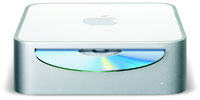 Apple Computer has unveiled updates to its iBook laptop and Mac Mini lines, lobbing in new features, more memory and built in wireless technology – although the anticipated widescreen models failed to run up at the launch party.
Apple Computer has unveiled updates to its iBook laptop and Mac Mini lines, lobbing in new features, more memory and built in wireless technology – although the anticipated widescreen models failed to run up at the launch party.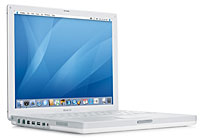 The new iBook G4s now come with a faster Power PC G4 processor running up to 1.42 GHz, with 512MB memory as standard, higher performance graphics and built-in AirPort Extreme and Bluetooth wireless connectivity.
The new iBook G4s now come with a faster Power PC G4 processor running up to 1.42 GHz, with 512MB memory as standard, higher performance graphics and built-in AirPort Extreme and Bluetooth wireless connectivity.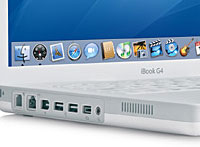 The 1.33 GHz PowerPC with 12″ screen G4 iBook retails at £699/US$999 and its bigger 1.42 GHz PowerPC G4 iBook with 14″ display knocks out for £899/US$1299.
The 1.33 GHz PowerPC with 12″ screen G4 iBook retails at £699/US$999 and its bigger 1.42 GHz PowerPC G4 iBook with 14″ display knocks out for £899/US$1299.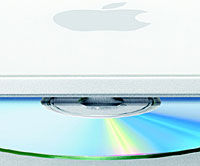 The diminutive Mac Mini range features three new models – the 1.25 GHz Mac Mini, 1.42 GHz Mac mini and the new 1.42 GHz Mac Mini with SuperDrive – with memory upgraded to 512 MB throughout.
The diminutive Mac Mini range features three new models – the 1.25 GHz Mac Mini, 1.42 GHz Mac mini and the new 1.42 GHz Mac Mini with SuperDrive – with memory upgraded to 512 MB throughout. Illegal music downloaders shell out more for legitimate music downloads than goody two-shoes music fans.
Illegal music downloaders shell out more for legitimate music downloads than goody two-shoes music fans.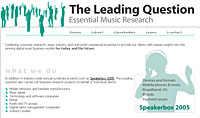 How much both groups spend on CDs wasn’t specified.
How much both groups spend on CDs wasn’t specified.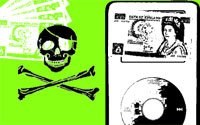 Respondents cited built-in cameras, organiser functions and video cameras above music players in their preferences for mobile phone features.
Respondents cited built-in cameras, organiser functions and video cameras above music players in their preferences for mobile phone features. As part of Motorola’s strategy to tempt home and business with new services, the company has announced that it will add Yahoo! Web services to their Linux-based mobile devices.
As part of Motorola’s strategy to tempt home and business with new services, the company has announced that it will add Yahoo! Web services to their Linux-based mobile devices. Ron Garriques, president of Motorola’s mobile device business, said: “By optimising these products for our leading Linux and Java software platform, we’re making it just that much easier for operators to maximize revenue while delivering the most innovative consumer experiences.”
Ron Garriques, president of Motorola’s mobile device business, said: “By optimising these products for our leading Linux and Java software platform, we’re making it just that much easier for operators to maximize revenue while delivering the most innovative consumer experiences.”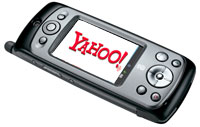 Elsewhere, the company have also announced that Vonage will offer the new Motorola VT2442 voice over Internet Protocol (VoIP) gateway to its Internet telephony customers.
Elsewhere, the company have also announced that Vonage will offer the new Motorola VT2442 voice over Internet Protocol (VoIP) gateway to its Internet telephony customers. Trying to work out the law surrounding this Wi-Fi malarkey seems to be a tricky business.
Trying to work out the law surrounding this Wi-Fi malarkey seems to be a tricky business.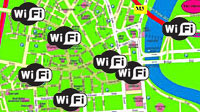 According to an article in the Financial Times, Microsoft says it has now built a database containing the whereabouts of “millions” of WiFi networks.
According to an article in the Financial Times, Microsoft says it has now built a database containing the whereabouts of “millions” of WiFi networks.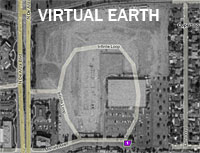 Microsoft has launched the first public beta of its Virtual Earth, an online mapping application overlaying satellite images with local searches and maps.
Microsoft has launched the first public beta of its Virtual Earth, an online mapping application overlaying satellite images with local searches and maps.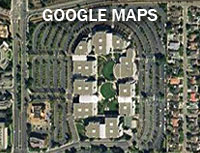 Virtual Earth will also have the capability to visually point out locations for ATMs, restaurants, and petrol stations – something that the rival Google Maps service has been able to do since incorporating satellite imagery in April this year.
Virtual Earth will also have the capability to visually point out locations for ATMs, restaurants, and petrol stations – something that the rival Google Maps service has been able to do since incorporating satellite imagery in April this year.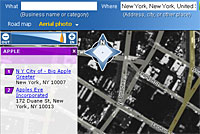 Mac users, however, will have to wait until autumn for a version that runs on their machines.
Mac users, however, will have to wait until autumn for a version that runs on their machines.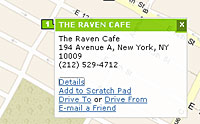 Wags on the Internet are claiming that Microsoft has virtually wiped Apple off the face of the Web, noting that Apple’s Silicon Valley headquarters – which can be seen in their full glory on Google Maps – appears as nothing more than a deserted parking lot in Virtual Earth.
Wags on the Internet are claiming that Microsoft has virtually wiped Apple off the face of the Web, noting that Apple’s Silicon Valley headquarters – which can be seen in their full glory on Google Maps – appears as nothing more than a deserted parking lot in Virtual Earth.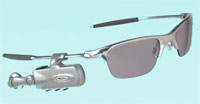 Put two cool branded products together – Motorola mobiles and Oakley sunglasses – and what do you get?
Put two cool branded products together – Motorola mobiles and Oakley sunglasses – and what do you get? The Bluetooth box clamps on to one of the arms of the sunglasses and sports volume controls and an answer button on its lower edge.
The Bluetooth box clamps on to one of the arms of the sunglasses and sports volume controls and an answer button on its lower edge.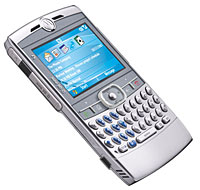 Billed as the “thinnest, lightest, coolest QWERTY on the Planet”, the new Q phone from Motorola has set a few hearts pounding in Chez Digi-Lifestyles.
Billed as the “thinnest, lightest, coolest QWERTY on the Planet”, the new Q phone from Motorola has set a few hearts pounding in Chez Digi-Lifestyles.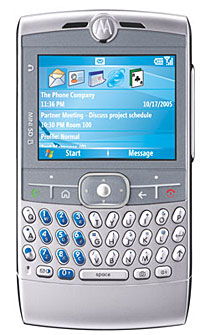 There’s a Mini-SD slot provided for extra storage and connectivity is taken care of via Bluetooth, IrDA and mini-USB.
There’s a Mini-SD slot provided for extra storage and connectivity is taken care of via Bluetooth, IrDA and mini-USB.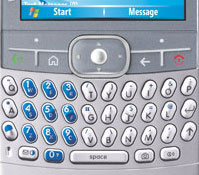 “With the Moto Q, we’ve combined the best voice, data and design technology in one ultra-thin, intelligent, hard-working, and incredibly must-have device. Today’s office space has the potential to be any place you want it to be with Q.”
“With the Moto Q, we’ve combined the best voice, data and design technology in one ultra-thin, intelligent, hard-working, and incredibly must-have device. Today’s office space has the potential to be any place you want it to be with Q.” The Moto Q is expected to be available in Q1 2006.
The Moto Q is expected to be available in Q1 2006. Sony Whips Out A White PSP
Sony Whips Out A White PSP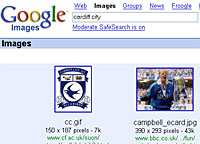 Google Grabs 47% Of All Searches Online
Google Grabs 47% Of All Searches Online London’s Ravensbourne College is launching a new program called the School of Computing for the Creative Industries.
London’s Ravensbourne College is launching a new program called the School of Computing for the Creative Industries. We would have thought that most of the passion manifests itself in the student bar, but the School insists that the new creative “understands that s/he is defined by the impact and credibility of their online presence.”
We would have thought that most of the passion manifests itself in the student bar, but the School insists that the new creative “understands that s/he is defined by the impact and credibility of their online presence.” All the technical facilities in the School will be built on open source platforms, with support offered to students wishing to release projects under free and open source licenses.
All the technical facilities in the School will be built on open source platforms, with support offered to students wishing to release projects under free and open source licenses.